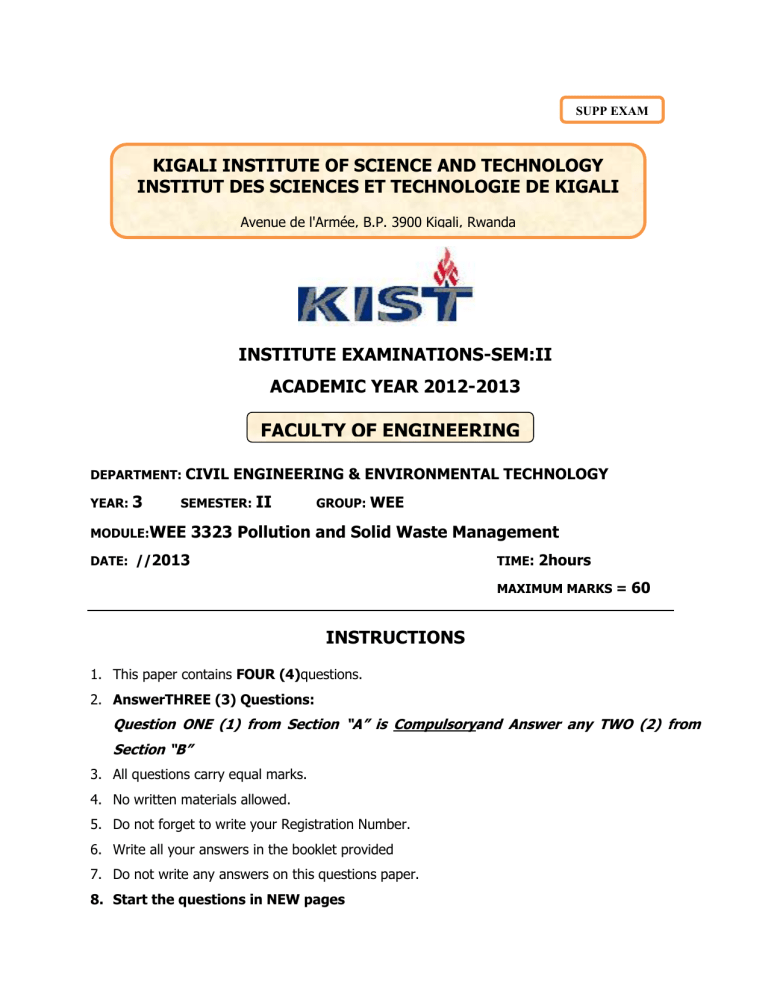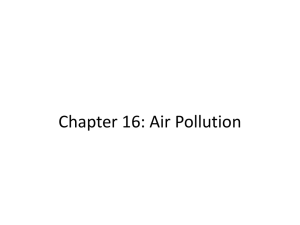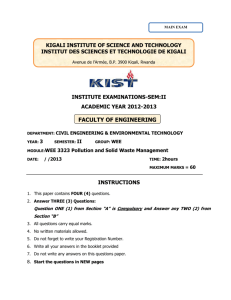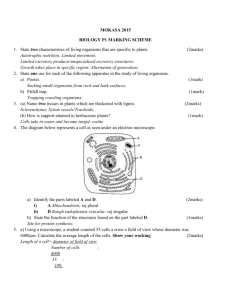SUP Y3 SemII Pollution & Solid Waste Mgt 2013

SUPP EXAM
KIGALI INSTITUTE OF SCIENCE AND TECHNOLOGY
INSTITUT DES SCIENCES ET TECHNOLOGIE DE KIGALI
Avenue de l'Armée, B.P. 3900 Kigali, Rwanda
INSTITUTE EXAMINATIONS-SEM:II
ACADEMIC YEAR 2012-2013
FACULTY OF ENGINEERING
DEPARTMENT: CIVIL ENGINEERING & ENVIRONMENTAL TECHNOLOGY
YEAR:
3
SEMESTER:
II
GROUP: WEE
MODULE:
WEE 3323 Pollution and Solid Waste Management
DATE: // 2013 TIME : 2hours
MAXIMUM MARKS = 60
INSTRUCTIONS
1.
This paper contains FOUR (4)questions.
2.
AnswerTHREE (3) Questions:
Question ONE (1) from Section “A” is Compulsoryand Answer any TWO (2) from
Section “B”
3.
All questions carry equal marks.
4.
No written materials allowed.
5.
Do not forget to write your Registration Number.
6.
Write all your answers in the booklet provided
7.
Do not write any answers on this questions paper.
8.
Start the questions in NEW pages
SECTION A
Question One: /20 Marks a) Explain how environment pollution has been increasing global concern over the public health impacts within the last three decades. /4marks b) i. What is pollution?/ 1Mark ii. What are the main types of pollution? /3Marks iii. What Causes Pollution?
/2Marks iv. What are the consequences of pollution?
/4Marks c) Categorize and classify the solid waste according to their Properties and according to their
Effects on Human Health and the Environment. /6Marks
SECTION B
Question Two: /20 Marks a) What is meant by Air pollution? /4Marks b) Categorize and distinguish air pollutants. / 4Marks c)
List out the six(6) principal, or “criteria” pollutants regulated by the US-EPA and most countries in the world. /6 Marks d) With examples, briefly distinguish the toxic pollutants, radioactive pollutants, and indoor pollutants.
/6 Marks
Question Three: /20 Marks a) What are the processes that are involved in effectively managing solid waste for a municipality?
/6 Marks b) Give reasons why methods of waste reduction, waste reuse and recycling are the preferred options when managing solid waste.
/6 Marks c) Describe the Integrated Solid Waste Management Hierarchy.
/8 Marks
Question Four: /20 Marks a) What are the long-term human health effects the Nyanza Kicukiro landfill may cause on the likelihoods of surrounding communities? /10Marks b) What risk management plan for Nyanza Landfill would you recommend to Kigali City
Council? /10Marks
GOOD LUCK
MARKING SCHEME
SECTION A
Question One: /20 Marks a) Explain how environment pollution has been increasing global concern over the public health impacts within the last three decades./4marks
R/: Over the last three decades there has been increasing global concern over the public health impacts attributed to environmental pollution, Human exposure to pollution is believed to be more intense now than at any other time in human existence. Pollution can be made by human activity and by natural forces as well. b) i.What is pollution? /1Mark ii. What are the main types of pollution? /3Marks ii.What Causes Pollution? /2Marks iii. What are the consequences of pollution?/4 Marks
R/: i.
Pollution is the introduction of harmful substances or products into the environment. 1Mark ii.
We will be examining 3 main parts of pollution: Water Pollution, Air Pollution, andLand
Pollution.
3Marks iii.
One of the main causes of air pollution is the release of carbon dioxide into the atmosphere, this happens because of Deforestation and fossil fuel burning. 2Marks iv.
Consequences of Air Pollution:
CO2 is a good transmitter of sunlight, but it also partially restricts infrared radiation going back from the earth into space, which produces the so-called greenhouse effect that prevents a drastic cooling of the Earth during the night. Increasing the amount of CO2 in the atmosphere reinforces this effect and is expected to result in a warming of the Earth's surface: CO2 in atmosphere -
Global Warming.
4Markss
Categorize and classify the solid waste according to their Properties and according to their Effects on Human Health and the Environment./6Marks
R/:
Classification of Wastes according to their Properties: 2Marks
Bio-degradable: can be degraded (paper, wood, fruits and others).
Non-biodegradable: cannot be degraded (plastics, bottles, old machines, cans, styrofoam containers and others).
Classification of Wastes according to their Effects on Human Health and the Environment:
4Marks
Hazardous wastes
Substances unsafe to use commercially, industrially, agriculturally, or economically that are shipped, transported to or brought from the country of origin for dumping or disposal in, or in transit through, any part of the territory of other country.
2 Marks
Non-hazardous
Substances safe to use commercially, industrially, agriculturally, or economically that are shipped, transported to or brought from the country of origin for dumping or disposal in, or in transit through, any part of the territory of other country.
2Marks
SECTION B
Question Two: /20 Marks a) What is meant by Air pollution? /4Marks
R/: Air pollution may be defined as the presence in the air (outdoor atmosphere) of one or more contaminants or combinations thereof in such quantities and of such durations as may be or tend to be injurious to human, animal or plant life, or property, or which unreasonably interferes with the comfortable enjoyment of life or property or conduct of business. b) Categorize and distinguish air pollutants./ 4Marks
R/: Air pollutants are airborne particles and gasses that occur in concentrations that endanger the health and well-being of organisms or disrupt the orderly functioning of the environment.
Pollutants can be grouped into two categories:
(1) Primary pollutants, which are emitted directly from identifiable sources, and 2Marks
(2) Secondary pollutants, which are produced in the atmosphere when certain chemical reactions take place among primary pollutants. 2Marks c)
List out the six (6) principal, or “criteria” pollutants regulated by the US-EPA and most countries in the world. /6 Marks
R/: Criteria Pollutants
As listed above, there are 6 principal, or “criteria” pollutants regulated by the
US-EPA and most countries in the world:
Total suspended particulate matter (TSP), 1Mark
Sulfur dioxide (SO2), 1Mark
Nitrogen oxides (NO and NO2), 1Mark
Carbon monoxide (CO), 1Mark
Ozone (O
3
), 1Mark
Lead (Pb).
1Mark d) With examples, briefly distinguish the toxic pollutants, radioactive pollutants, and indoor pollutants. /6 Marks
R/:Toxic Pollutants 2Marks
Hazardous air pollutants (HAPS), also called toxic air pollutants or air toxics. Those pollutants that cause or may cause cancer or other serious health effects, such as reproductive effects or birth defects. Examples of toxic air pollutants include benzene, which is found in gasoline; perchlorethlyene, which is emitted from some dry cleaning facilities; and methylene chloride, which is used as a solvent and paint stripper by a number of industries.
Radioactive Pollutants 2Marks
Radioactivity is an air pollutant that is both geogenic and anthropogenic. Geogenic radioactivity results from the presence of radionuclides, which originate either from radioactive minerals in the earth’s crust or from the interaction of cosmic radiation with atmospheric gases. Anthropogenic radioactive emissions originate from nuclear reactors, the atomic energy industry (mining and processing of reactor fuel), nuclear weapon explosions, and plants that reprocess spent reactor fuel.
Indoor Pollutants 2Marks
When a building is not properly ventilated, pollutants can accumulate and reach concentrations greater than those typically found outside. This problem has received media attention as “Sick Building Syndrome”.
Environmental Tobacco Smoke (ETS) is one of the main contributors to indoor pollution, as are CO, NO, and
SO2, which can be emitted from furnaces and stoves.
Question Three: /20 Marks a) What are the processes that are involved in effectively managing solid waste for a municipality?
/6 Marks
R/: A number of processes are involved in effectively managing waste for a municipality. These include
monitoring, 1Mark
collection, 1Mark
transport, 1Mark
processing, 1Mark
recycling 1Mark
and disposal.
1Mark b) Give reasons why methods of waste reduction, waste reuse and recycling are the preferred options when managing solid waste. /6 Marks
R/: Methods of waste reduction, waste reuse and recycling are the preferred options when managing waste.
Waste reduction methods: An important method of waste management is the prevention of waste material being created, also known as waste reduction. Methods of avoidance include reuse of second-hand products and repairing broken items instead of buying new. 2Marks
Recycling: Items that are usually composed of a single type of material are relatively easy to recycle into new products i.e. paper and plastics. The recycling of complex products (such as computers and electronic equipment) is more difficult, due to the additional dismantling and separation required.
2Marks
Methods of waste reduction include manufacturing products with less packaging, encouraging customers to bring their own reusable bags for packaging, encouraging the public to choose reusable products such as cloth napkins and reusable plastic and glass containers, backyard composting and sharing and donating any unwanted items rather than discarding them. 2Marks c) Describe the Integrated Solid Waste Management Hierarchy. /8 Marks
R/:
Question Four: /20 Marks a) What are the long-term human healths the landfill may impact on the likelihoods of Nyanza
Kicukiro communities? /10Marks
R/:
The refuse composition at Nyanza Kicukiro Landfill is highly diverse: papers, glass, metal, plastics paint wastes, TV scraps, organics, textile, special care, waste, construction and street debris etc.
2Marks
Some of which are sources of heavy metals such as lead, mercury, cadmium, copper, zinc, etc that are highly toxic and have the ability to bioacummulate / biomaginfy through food chain transfer.
2Marks
They can cause chronic human health risks that are fetal and are felt immediately or after a long period of time. 2Marks
These elements especially Mercury, Cadmium and lead are toxic even at very low concentration.
2Marks
Theseelements do not decomposes or degrade, they causes damage to the brain nervous and reproductive systems leading to neurotoxicity and birth defects respectively. 2Marks b) What risk management plan for Nyanza Landfill would you recommend to Kigali City
Council? /10Marks
R/:
Risk assessment or Pathways analysis is necessary to be conducted in order to understand the risk or hazard associated with a disposal or waste management facility.
2Marks
Risk based management allows decisions to be made regarding waste facilities or contaminated sites that are quantitative objective, and consistent for different sites and facilities with different characteristics.
2Marks
Waste Volumes/size: must be managed 2Marks
Thermal Values from residual waste can be harvested and used as fuel for incinerators.
The hazardous wastes;
2Marks the most important factor in determining how a waste should be managed is its hazard toxicity.
2Marks
Thank You









